Sapling AI Detector Review: 3 Tests Show Real Accuracy

Curious if Sapling AI detector can really spot AI writing? You might be wondering how accurate it is and whether they can trust the results. In this article, we put the Sapling AI detector to the test across different types of text and break down its features, limitations, and pricing. We’ll also explore ways text can affect detection. Keep reading to see how it performs and what you should know before relying on it.

What Is Sapling?
Sapling is a language model platform created by former researchers from Google, Stanford, and UC Berkeley. It provides AI tools for business communication, offering grammar and style improvements, message suggestions, and an AI detector for identifying machine-generated text.
What Is Sapling AI Detector?
The AI detector inside Sapling relies on a transformer-based system, similar to the models that produce AI text, to estimate whether a passage was written by a person or by an AI.
The detector supports common file types like PDF and DOCX, and it can also process HTML inputs. There’s also a Chrome extension for quick checks while browsing or writing directly in the browser.
Looking ahead, Sapling has plans to expand its detection capabilities. According to their roadmap, a feature is in the works to analyze whether code has been AI-generated, though that isn’t available yet.
Extra Tools in Sapling
Beyond detection, Sapling offers a set of tools that make it a versatile writing assistant. These include:
AI Grammar Check – helps clean up grammar mistakes.
AI Punctuation Check – ensures clarity and proper punctuation.
Sentence Rewriter – offers alternative ways to phrase text.
LLM Index – organizes and manages language model resources.
Snippets – saves and reuses commonly typed responses.
Chat Assist – provides quick, context-aware suggestions during conversations.
How Accurate Is Sapling AI Detector?
Sapling claims its AI detector can reliably distinguish between human and machine-written text. But how accurate is it in practice? To find out, we ran a series of tests with different kinds of text—from fully AI-generated to mixed writing and even humanized AI content.
Test 1: Pure AI Text
Setup:
To start, we generated a passage entirely with ChatGPT-5. This test is the simplest baseline: if it works as advertised, it should have no trouble labeling it as AI.
Results: Sapling AI detector flagged the text as 100% AI.
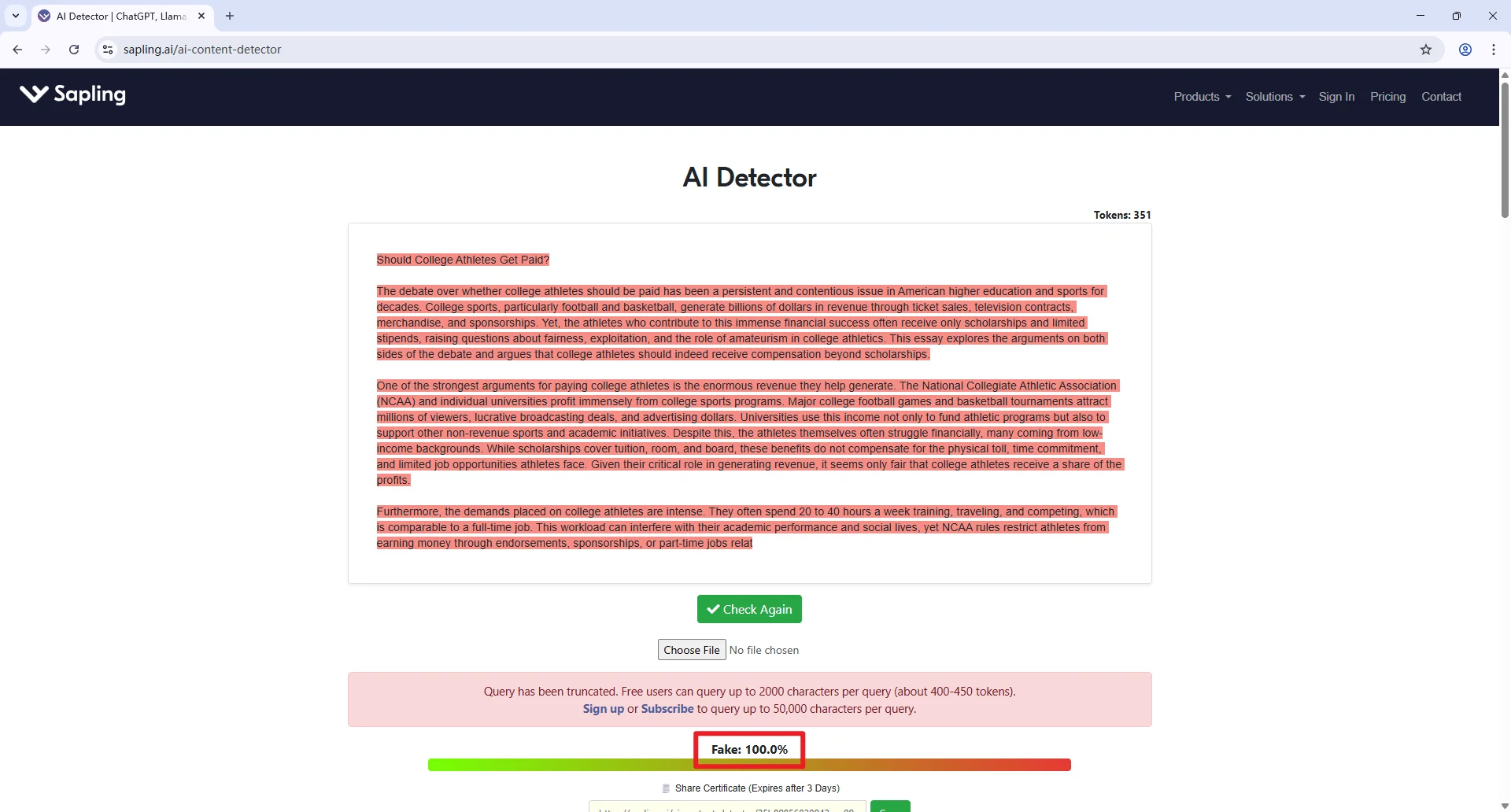
Observations: When the input is completely AI-generated, Sapling’s system has no difficulty identifying it. At this stage, its accuracy looks strong.
Test 2: Mixed AI + Human Writing
Setup:
For the second test, we combined sources. We took a paragraph from an older human-written paper and let ChatGPT-5 continue it. The total length was 454 words, with nearly a 60/40 split between AI and human contributions.
Results: Sapling AI detector again flagged the text as 100% AI.
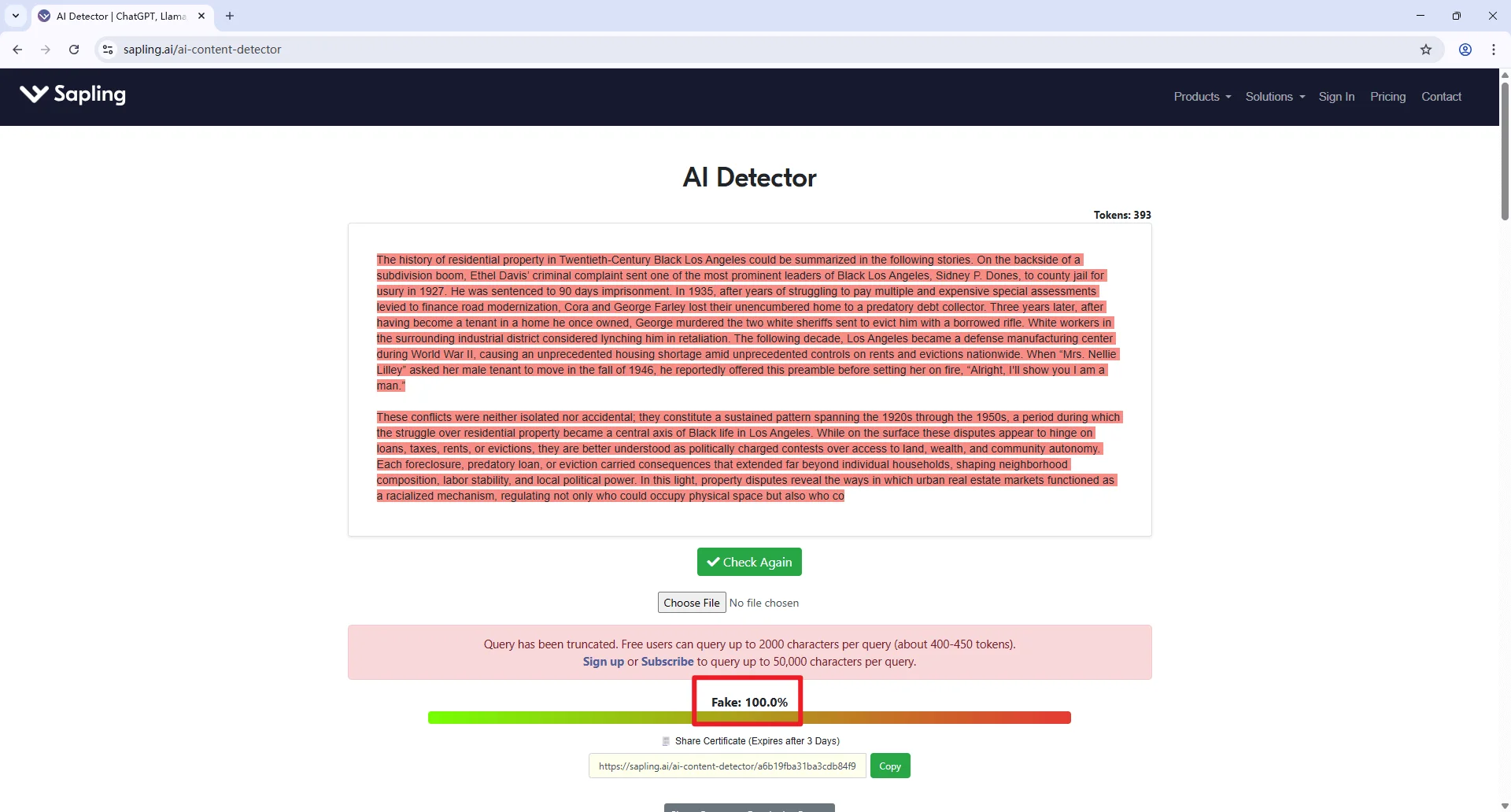
Observations:
Here’s where things get tricky. Even though nearly half of the text was clearly human, Sapling labeled the entire piece as AI. That suggests the system struggles to separate mixed writing, leaning toward caution by tagging the whole thing as machine-generated. For students or writers, this could mean a risk of false positives in cases where AI is used only to supplement original work.
Test 3: Humanized AI Text by QuillBot
Setup:
In the final test, we wanted to see how Sapling handles humanized AI text. We took the passage from Test 1 (100% AI) and rewrote it using QuillBot AI Humanizer in basic mode.
Results: Sapling marked the text as only 9.3% AI.
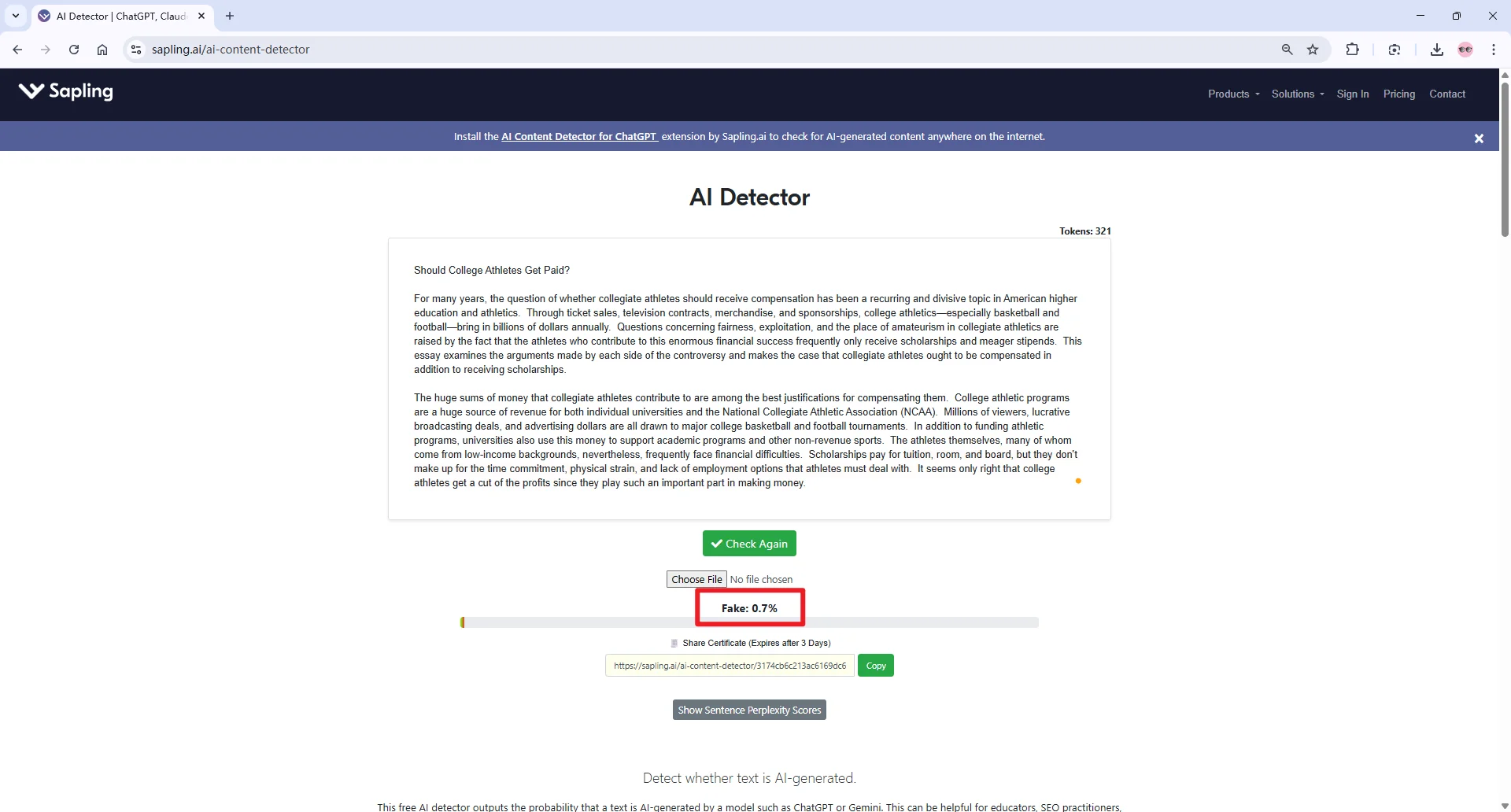
Observations:
The score shows that QuillBot AI Humanizer in basic mode can lower the AI rating quite a bit. It doesn’t make the text fully human, but it hides most AI patterns. That said, it’s not perfect—simple rewrites can help, but some AI traces can still slip through.
Pros and Cons of Sapling AI Detector
Pros
Broad AI model detection: Can identify text generated by ChatGPT, Jasper, and other common AI tools, useful for evaluating both academic and professional writing.
Convenient input formats: Users can paste text or upload full documents (like PDFs), adding flexibility for different workflows.
Browser and app extensions: Offers extensions for Chrome, Google Docs, Outlook, and Word. You can run detection directly while writing and even edit flagged text before rechecking it.
Cons
Inconsistent accuracy: Struggles with identifying mixed human-AI content, sometimes leading to misleading outcomes.
Surface-level evaluation: The detector focuses mainly on sentences without deeper analysis of flow, coherence, or overall style.
Limited language support: Currently optimized for English only, reducing its accessibility for multilingual or non-English users.
Sapling Pricing
Free Plan
Sapling’s free plan lets you check an unlimited number of texts up to 2,000 characters each. It’s suitable for short paragraphs or quick checks. For longer texts, you’ll need to split them into smaller sections, and the free plan does not include advanced features like extended AI detection or premium writing tools.
Paid Plans for Individuals
The Pro plan costs $25 per month (or $12 per month if billed annually) and supports queries of up to 50,000 characters. It also includes the AI detector for longer texts, snippets, rephrasing, and chat assistance, making it more convenient for full-length essays or detailed documents. A free one-month trial is available for new users.
Paid Plans for Enterprise
Sapling offers an Enterprise plan for teams starting at 10 seats, $15 per user per month. This plan provides additional features such as bulk user management, advanced security, dedicated support, and extended AI detection capabilities. Pricing is customized, so organizations need to contact Sapling directly.
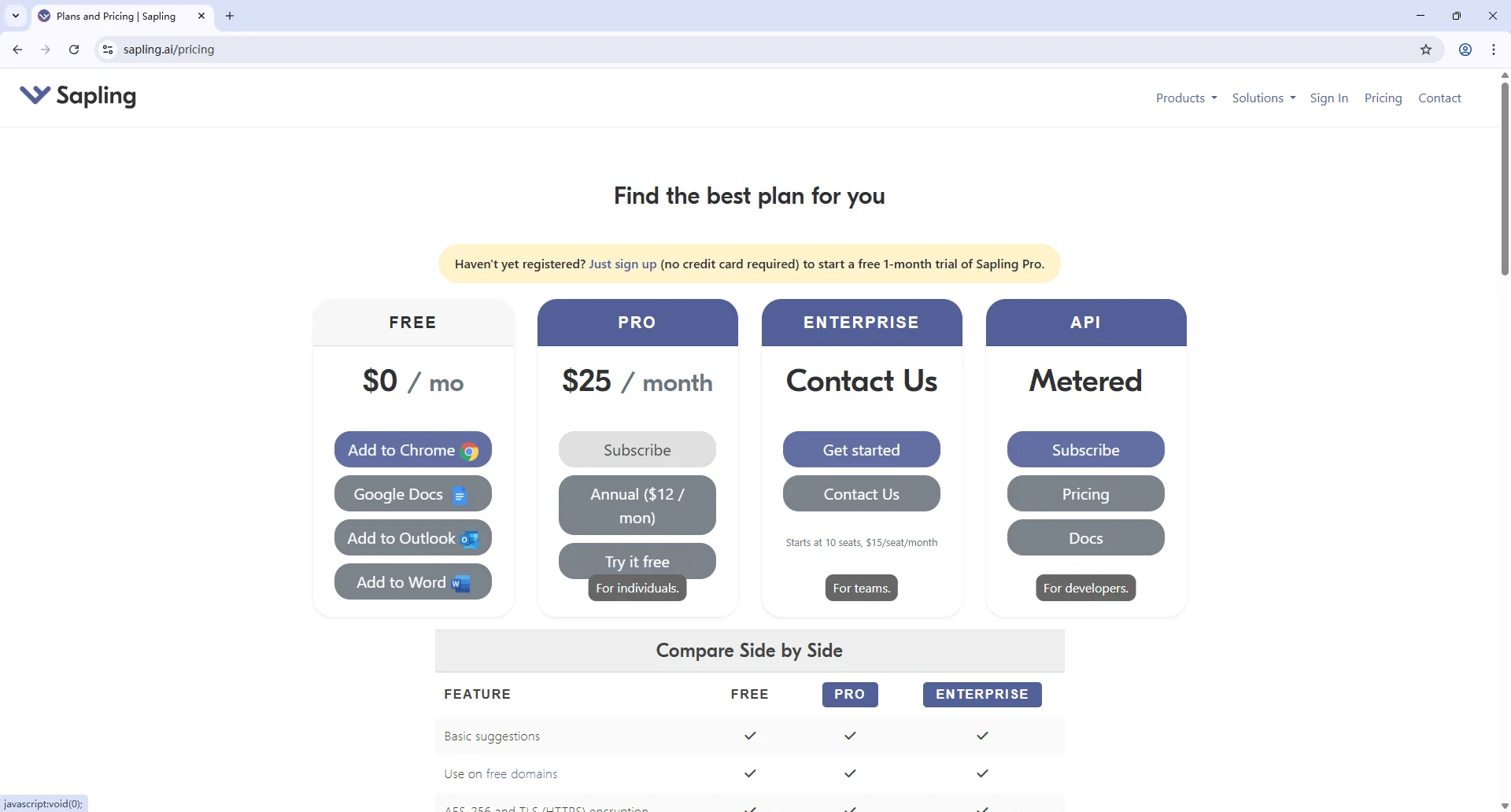
Can You Bypass Sapling AI Detector?
So, can Sapling be bypassed? The answer is yes. While it can detect fully AI-generated text, there are ways to reduce its detection and make your writing sound more natural.
However, getting a low AI score and producing high-quality, natural-sounding text are two very different things. You certainly don’t want your writing to come across as stiff, awkward, full of grammar mistakes, or obviously machine-generated—even if it ends up with a 0% AI score. Whether it’s an essay, a report, or a professional message, your text should flow smoothly and read as if it were crafted by a human.
That’s where the advanced EssayDone Humanizer makes a real difference. It doesn’t just lower the AI score. It restructures sentences, refines word choices, and smooths stylistic patterns. The result is AI-generated text that reads clearly and naturally.
I also ran a test using the paragraph from Test 1, which Sapling originally flagged as 100% AI. After processing with EssayDone, the AI score dropped to 0%. All detectable AI traces were removed, and the text remained fully readable and professional.

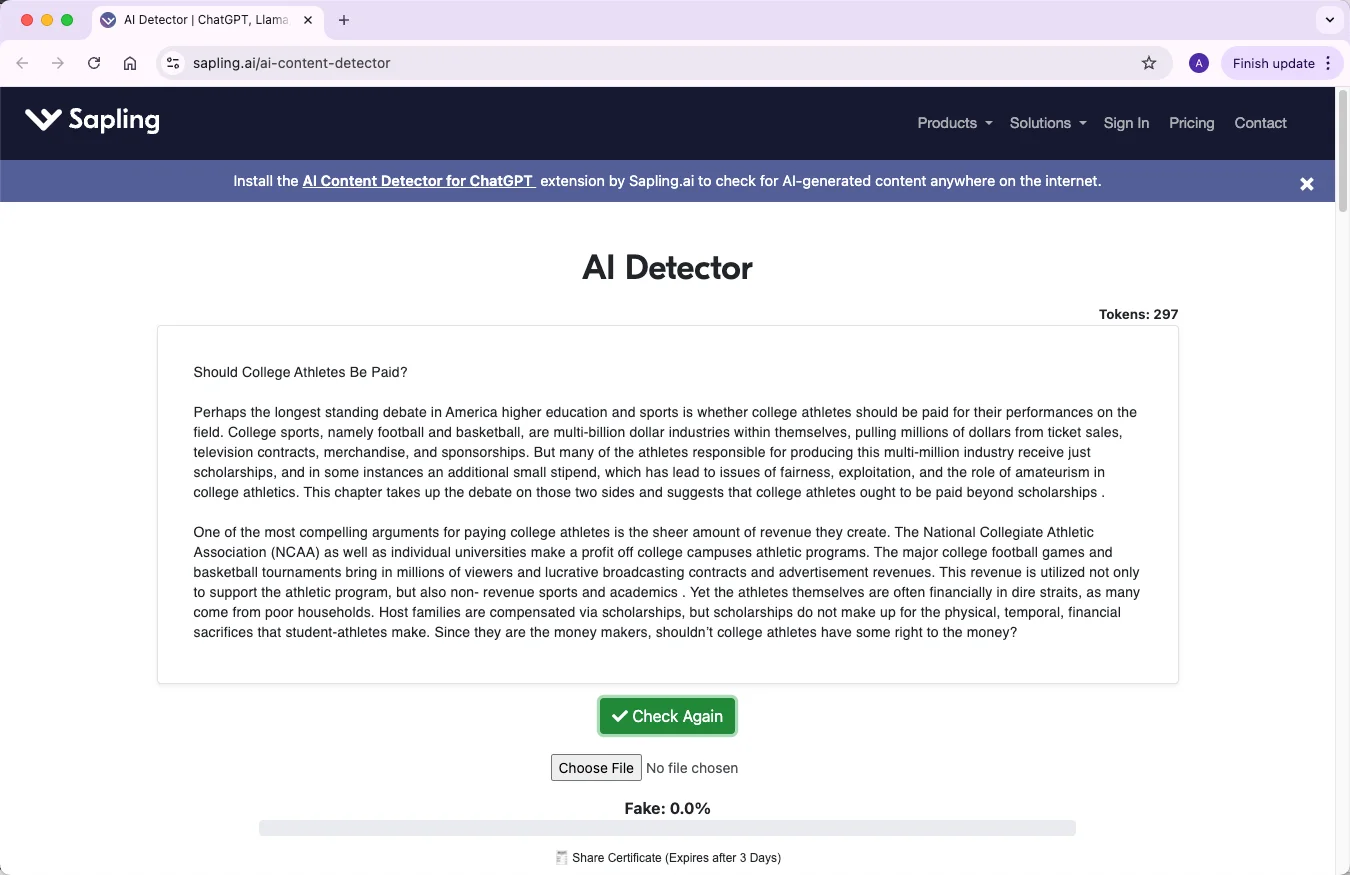
Alternatives to Sapling AI Detector
Tool | Multilingual | Free Plan | Paid Plan | File Formats | Login Required | Sentence-Level Analysis | Extra Features |
Yes | Limited trial only | From $12.95/mo (200k words, 2k credits) | PDF, DOCX, DOC, site scans | Yes | Yes | Plagiarism check, fact check, readability, grammar, team tools, Chrome extension | |
GPTZero | Yes | 5,000 characters/test | From $14.99/mo (100k chars) | PDF, DOC, DOCX, TXT (50MB max) | Yes | Yes | Writing feedback, plagiarism check, citation tools |
Copyleaks | Yes (30+ langs) | 15,000 characters/test | From $16.99/mo (100k chars) | Copy-paste only | No | No | AI + plagiarism in one report, shared data hub, Google Docs add-on, Chrome extension |
ZeroGPT | Yes | Yes | From $9.99/mo | Text only | No | No | Plagiarism check, AI summarizer, AI paraphraser |
QuillBot | Yes | 1,200 words/test | From $8.33/mo, Unlimited Scan with premium | Multiple (DOCX, TXT, etc.) | No | Yes | Paraphraser, summarizer, grammar check, plagiarism check, text humanizer |

FAQ
Q: Is Sapling AI Detector 100% accurate?
No. While it performs well on fully AI-generated text, it can overestimate AI content in mixed writing or fail to detect lightly humanized AI text. Short, generic, or essay-like passages are particularly prone to false positives.
Q: How to bypass the Sapling AI Detector?
Simple rewriting or word swaps may lower AI scores, but results are inconsistent. Professional humanizers, like EssayDone Humanizer, make linguistic and structural changes that significantly reduce AI patterns while keeping the text readable.
Q: Will my professor use an AI detector?
It depends on the school and the professor. Many universities are adopting AI detection tools, but not everyone uses them. Policies also vary, so it’s good to check your institution’s rules on AI-assisted writing.
Q: Can I use AI detectors on my own work before submission?
Yes. Running your work through a detector can help identify sections that might appear AI-generated and allow you to edit them before submitting. This is a proactive way to avoid false positives.
Q: Are AI detectors legal?
Yes. Using AI detectors is legal. They are tools for checking the authorship of text, similar to plagiarism checkers, and do not violate any laws when used appropriately.
Q: Is Sapling AI Detector free?
Sapling offers a free plan with up to 2,000 characters per query. For longer texts or more frequent use, the Pro plan costs $25/month and supports up to 50,000–100,000 characters per query.
Conclusion
We’ve gone through Sapling AI Detector in detail—from how it works and its accuracy in different text scenarios to pros and cons, pricing, and ways AI-generated text can be humanized. The tests show it can be reliable with fully AI content, but may misjudge mixed or lightly humanized writing. By understanding these limitations, you can use the detector more effectively and avoid false positives. Hopefully, this guide helps you make informed decisions and write with more confidence.
